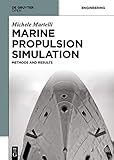Marine Propulsion Simulation : Methods and Results.
Yazar:Martelli, Michele
Materyal türü: KonuYayıncı: Warschau/Berlin : Walter de Gruyter GmbH, 2015Telif hakkı tarihi: �2015Tanım: 1 online resource (112 pages)İçerik türü:text Ortam türü:computer Taşıyıcı türü: online resourceISBN: 9783110401509Konu(lar): Marine diesel motors | Marine engines | Ship propulsionTür/Form:Electronic books.Ek fiziksel biçimler:Print version:: Marine Propulsion SimulationDDC sınıflandırma: 623.812 LOC classification: VM779 .M384 2015Çevrimiçi kaynaklar: Click to View
KonuYayıncı: Warschau/Berlin : Walter de Gruyter GmbH, 2015Telif hakkı tarihi: �2015Tanım: 1 online resource (112 pages)İçerik türü:text Ortam türü:computer Taşıyıcı türü: online resourceISBN: 9783110401509Konu(lar): Marine diesel motors | Marine engines | Ship propulsionTür/Form:Electronic books.Ek fiziksel biçimler:Print version:: Marine Propulsion SimulationDDC sınıflandırma: 623.812 LOC classification: VM779 .M384 2015Çevrimiçi kaynaklar: Click to View Intro -- 1 Introduction -- 2 Ship Dynamics -- 2.1 Simulation Approach -- 2.2 Literature Review -- 2.3 Ship Dynamics -- 2.3.1 Rigid Body Dynamics -- 2.3.2 Propulsion plant dynamics -- 2.3.3 Control system -- 2.4 System of Systems -- 3 Ship Propulsion Plant -- 3.1 Main Engines -- 3.1.1 Gas Turbine -- 3.1.2 Electric Propulsion Motor -- 3.2 Transmission Line -- 4 Propulsion Control -- 4.1 Propulsion Control System -- 4.1.1 Ramps -- 4.1.2 Combinator Law -- 4.1.3 Protections -- 4.2 Emergency Manoeuvres -- 4.2.1 Slam Start -- 4.2.2 Crash Stop -- 4.3 Real Time Hardware In the Loop (RT-HIL) -- 5 Motion Equations -- 5.1 Reference Frame -- 5.2 Kinematics -- 5.3 6 D.O.F. Motion Equation -- 5.4 Proposed Forces Evaluation -- 5.4.1 Hull Forces -- 5.4.2 Propulsion Forces -- 5.4.3 Rudder Forces -- 5.4.4 Environmental Forces -- 5.4.5 Restoring Forces -- 6 Propeller & -- Pitch Change Mechanism -- 6.1 Pitch Change Mechanism -- 6.2 Reference Frame -- 6.3 Motion and Pressure Differential Equation -- 6.4 Forces Evaluation -- 6.4.1 Inertial Forces -- 6.4.2 Propeller Hydrodynamic Forces -- 6.4.3 Frictional Forces -- 6.4.4 Hydraulic Forces -- 7 Rudder -- 7.1 Reference Frame -- 7.2 Hull - propeller - rudder interactions -- 7.3 Proposed Forces Evaluation -- 8 Validation -- 8.1 Comparison -- 8.1.1 Slam Start -- 8.1.2 Turning -- 8.1.3 Zig Zag -- 9 Conclusions -- Acknowledgement -- Nomenclature -- Appendix -- Bibliography -- Index.
This book describes the main steps in developing a multi-physics simulation platform, representing the dynamics of a twin screw ship in six degrees of freedom. The interaction between the propulsion system and automation effects is also considered. The presented simulation methodology can be used in the preliminary ship design to analyse propulsion and control system action. Further applications can concern design optimization and crew training.
Description based on publisher supplied metadata and other sources.
Electronic reproduction. Ann Arbor, Michigan : ProQuest Ebook Central, 2022. Available via World Wide Web. Access may be limited to ProQuest Ebook Central affiliated libraries.







There are no comments on this title.